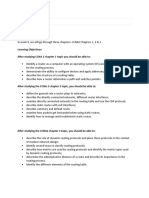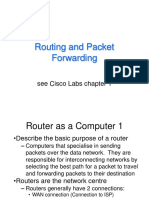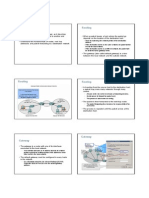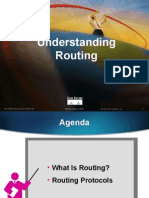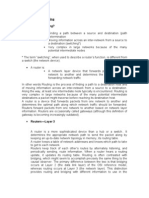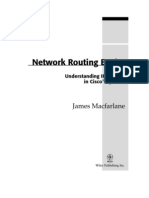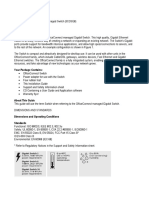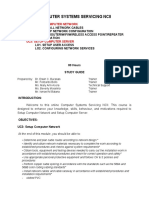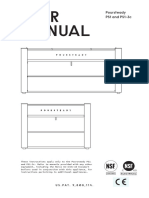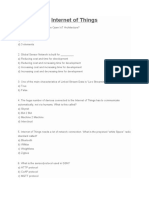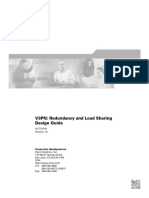Routing Basics: A Comprehensive Overview
1 Introduction
Routing is the process of exchanging data packets between separate networks
interconnected by routers. This document provides a professional overview of
routing fundamentals, including the roles of routers, autonomous systems, rout-
ing tables, route calculation, and evaluation criteria for routing protocols.
2 Routing Fundamentals
Routing enables communication across interconnected networks by facilitating
the exchange of data packets. Key aspects include:
• Intra-Subnet Communication: When a node sends a packet to another
node within the same subnet, a router is not required. The Address Reso-
lution Protocol (ARP) resolves the destination node’s address and stores it
in the ARP cache for efficient communication.
• Inter-Subnet Communication: For communication between nodes in dif-
ferent subnets, the sending node forwards the packet to a router. The router
then directs the packet toward the destination subnet.
• Logical Adjacency: Machines across internetworked systems maintain log-
ical adjacency, similar to devices on the same local area network (LAN).
Routers play a critical role in complex networks by:
• Discovering and tracking the internetwork topology.
• Identifying subnetwork and host addresses.
• Evaluating optimal and suboptimal routes.
• Balancing traffic loads across redundant optimal routes.
3 Autonomous Systems (AS)
An Autonomous System (AS) is a self-contained network, either a LAN or WAN,
managed by a single entity or group. Characteristics include:
• A unified routing protocol and address architecture.
1
� • Typically employs a single routing protocol.
• May connect to other autonomous systems operated by the same organiza-
tion.
4 Routers
Routers are pivotal devices in internetworks, performing specialized functions
to ensure efficient data transfer. They operate at Layer 3 of the OSI model and
utilize two types of protocols:
• Routable Protocols: Protocols like IP encapsulate user data into packets
for transport across networks.
• Routing Protocols: These protocols enable routers to discover routes, share
routing information, and forward packets to their destinations.
4.1 Router Roles
Routers serve various roles in an internetwork:
• Interior Gateways: Manage routing information within a single domain
or autonomous system.
• Exterior Gateways: Collect and share routing information about external
networks.
• Border Routers: Interconnect autonomous systems, marking the bound-
ary between them.
4.2 Physical Components
A router consists of:
• Central Processing Unit (CPU)
• Random Access Memory (RAM)
• Basic Input/Output System (BIOS)
• Operating System (OS)
• Motherboard
• Physical Input/Output (I/O) Ports
• Power Supply, Chassis, and Enclosure
Routers require at least two physical interfaces to connect LANs or WANs and
maintain tables correlating Layer 3 addresses with connected ports.
5 Routing Tables
Routers make forwarding decisions using routing tables, which contain:
2
� • Destination IP address (often a subnet address).
• Subnet mask of the destination.
• Next-hop gateway address.
• Interface IP address for reaching the next hop.
• Routing metrics for path evaluation.
Routing tables were historically configured manually but are now primarily built
dynamically using routing protocols. Routers exchange updates to reflect changes
in network topology, such as link failures or node additions.
6 Route Calculation and Maintenance
Route calculation involves:
• Looking up destination addresses in the routing table.
• Matching addresses to known ports.
• Forwarding packets if permitted by the access control list (ACL); otherwise,
dropping the packet and potentially sending an error message.
Routing protocols enable routers to:
• Identify potential routes to destinations.
• Calculate the optimal path using mathematical comparisons.
• Monitor network topology for changes that may invalidate routes.
Examples of routing protocols include:
• Routing Information Protocol (RIP)
• Open Shortest Path First (OSPF)
• Interior Gateway Routing Protocol (IGRP)
7 Routing Protocols Evaluation Criteria
Routing protocols are evaluated based on several criteria:
• Optimality: The ability to select the best route, often based on metrics like
hop count.
• Efficiency: Measured by resource usage, including router RAM, CPU, and
network bandwidth.
• Robustness: Reliable performance under error conditions, such as hard-
ware failures or heavy traffic.
• Convergence: The speed at which a protocol detects and adapts to network
changes. Slower convergence may disrupt service.
3
� • Scalability: The ability to handle network growth.
• Security: Managed through access permissions defined per port in access
control lists.
8 Conclusion
Routing is a foundational process in network communication, enabling seamless
data exchange across interconnected systems. Routers, supported by routing
protocols and tables, ensure efficient, reliable, and secure data transfer. Under-
standing these concepts is essential for designing and managing robust network
infrastructures.

















